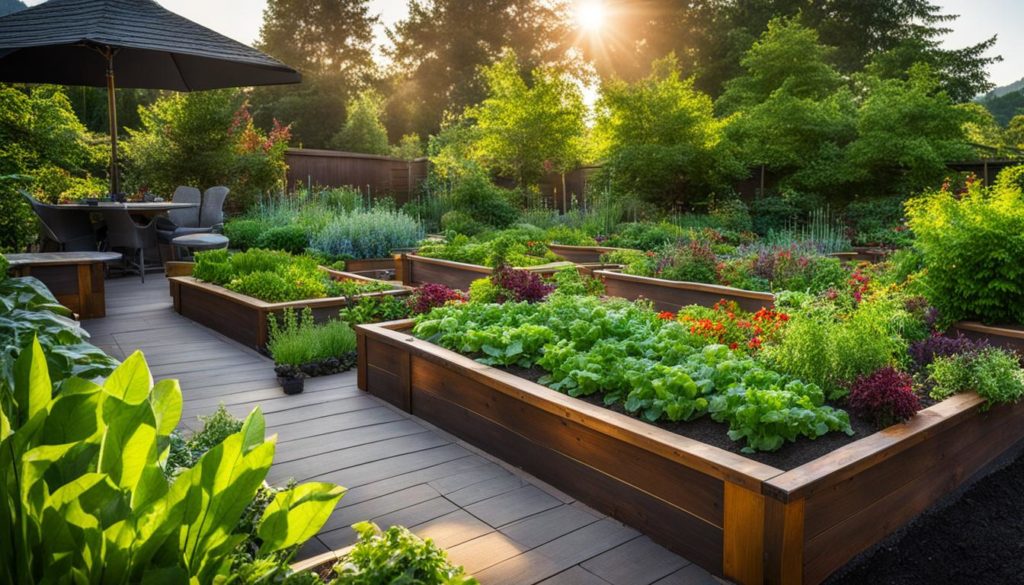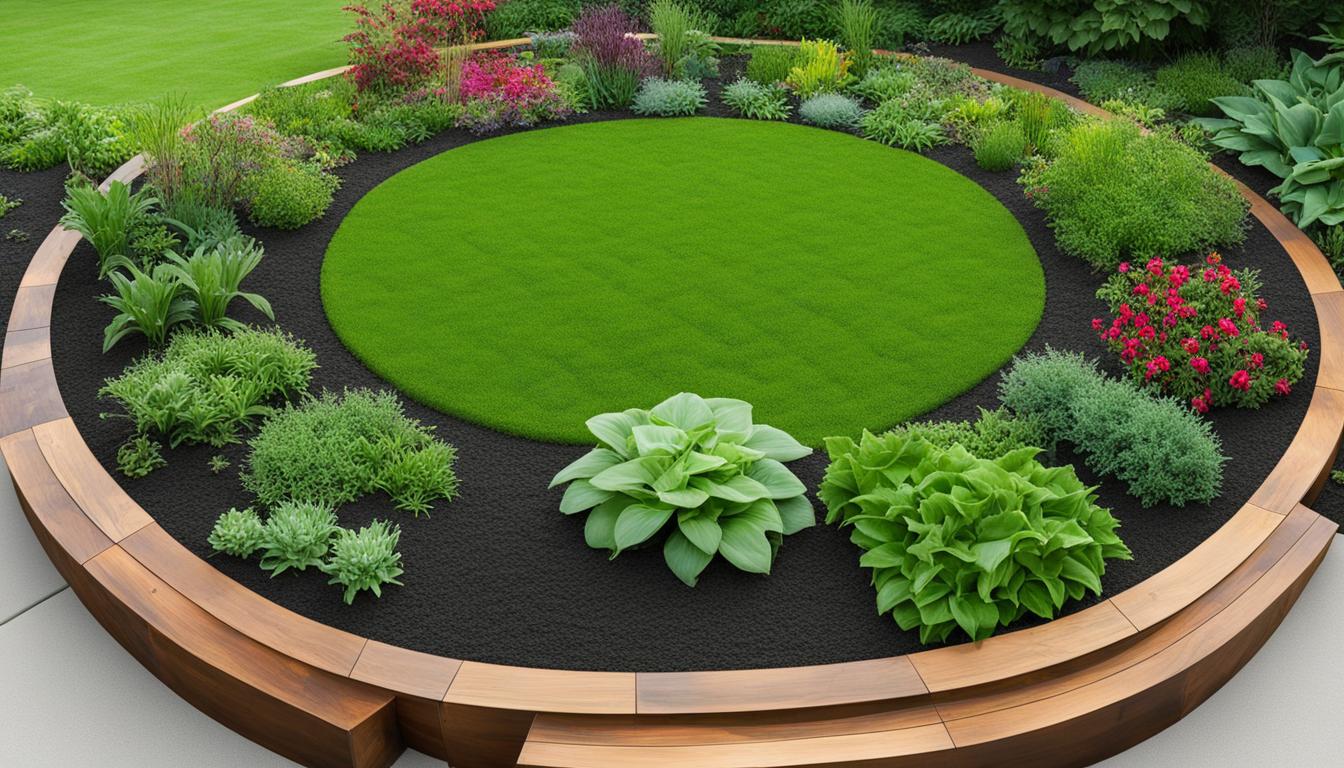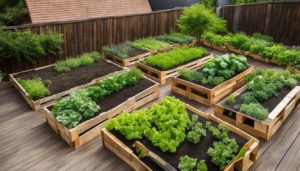Are you ready to take your gardening to new heights? Off the ground garden beds are the answer. These raised beds provide a multitude of benefits, from improved drainage to easier maintenance. Whether you’re a seasoned gardener or just starting out, off the ground garden beds will elevate your gardening game.
Early spring is the perfect time to build your raised beds. With a few simple considerations, you can create a customized gardening space that will yield a bountiful harvest. From choosing the right materials to maximizing your planting space, this article will guide you through the process of building, maintaining, and reaping the rewards of off the ground garden beds.
Key Takeaways:
- Off the ground garden beds provide improved drainage and prevent soil erosion
- Maintaining raised beds is easier and requires less bending and kneeling
- Strategic planting and maximizing space in raised beds can significantly increase your harvest
- Using the Hugelkultur Method or lasagna gardening can save money when filling raised beds
- Raised garden beds offer a controlled environment, weed control, and pest management benefits
Building and Maintaining Raised Beds
Once you have constructed your raised bed, it is important to know how to effectively build and maintain it to ensure optimal plant growth and yield. By following these steps, you can create a thriving garden in your raised bed.
Building
When building your raised bed, start by filling it with a nutrient-rich soil mixture. Use a combination of quality topsoil, compost, and organic matter to provide the ideal environment for your plants. Ensure that the soil is well-draining to prevent waterlogging and root rot.
Next, consider the layout and spacing of your crops. Square foot gardening is a popular technique that involves dividing your raised bed into square sections and planting different crops in each square. This maximizes space and allows for efficient use of resources.
Furthermore, be mindful of crop rotation to maintain soil health. Rotate your crops each season to prevent nutrient depletion and reduce the risk of pests and diseases. This practice ensures that your plants receive a balanced diet and minimizes the need for chemical interventions.
Maintaining
Regular maintenance is key to the success of your raised bed garden. Water your plants consistently, aiming to keep the soil moist but not waterlogged. Mulching the surface of the soil with organic materials like straw or wood chips can help conserve moisture and suppress weed growth.
Additionally, keep an eye out for pests and diseases. Inspect your plants regularly and take appropriate measures to control any infestations or infections. Organic pest control methods such as hand-picking pests or applying natural insecticides can help protect your crops without harming the environment.
Finally, don’t forget to fertilize your raised bed garden. Organic fertilizers like compost or well-decomposed manure can provide a slow-release source of nutrients for your plants. Follow the recommended application rates to avoid over-fertilization, which can lead to nutrient imbalances or environmental pollution.
| Crop | Planting Time | Spacing |
|---|---|---|
| Tomatoes | After last frost | 2-3 feet apart |
| Spinach | Early spring or fall | 4-6 inches apart |
| Kale | Early spring or fall | 12-18 inches apart |
| Bush beans | After last frost | 4-6 inches apart |
Filling a Raised Garden Bed for Less
When it comes to filling your raised garden beds, there are cost-effective methods that can help you save both soil and money. One popular approach is the Hugelkultur Method, which involves layering organic materials to create a nutrient-rich environment for your plants. Start by placing sticks, twigs, or wood stumps at the base of the bed to provide drainage. Then, add landscape fabric or cardboard to prevent weed growth.
Next, incorporate gravel or rocks to further improve drainage. This is especially important if your raised bed is located in an area with heavy rainfall. After the drainage layer, you can begin adding layers of grass clippings, straw, sandy soil, and compost. These materials will gradually decompose, enriching the soil and creating a fertile foundation for your plants.
Not only is the Hugelkultur Method a cost-effective way to fill your raised beds, but it also promotes sustainable gardening practices by utilizing organic materials and minimizing waste. By following this approach, you can create a thriving garden while reducing your environmental impact and enjoying the benefits of a flourishing harvest.
| Materials | Benefits |
|---|---|
| Sticks, twigs, or wood stumps | Provide drainage |
| Landscape fabric or cardboard | Prevent weed growth |
| Gravel or rocks | Improve drainage |
| Grass clippings, straw, sandy soil, compost | Enrich soil and promote decomposition |
Benefits of Raised Garden Beds
Raised garden beds offer numerous advantages that can elevate your gardening experience. Whether you’re a seasoned gardener or a beginner, incorporating raised beds into your garden brings several benefits that can help you create a thriving and productive growing space.
Improved Drainage and Soil Quality
One of the main advantages of raised garden beds is their excellent drainage. The raised structure allows excess water to drain more efficiently, preventing waterlogging and root rot. Additionally, you have full control over the soil composition, allowing you to create a customized mixture that meets the specific needs of your plants. This ensures optimal soil quality, which promotes healthy root development and overall plant growth.
Enhanced Accessibility and Weed Control
Raised beds offer a higher working height, reducing the need for bending and kneeling during gardening tasks. This accessibility benefit is especially valuable for individuals with physical limitations or those who prefer a more comfortable gardening experience. Additionally, the defined boundaries of raised beds make it easier to control and manage weeds. With clear boundaries, it’s simpler to identify and remove unwanted plants, reducing competition for nutrients and resources.
Pest Management and Protection
By elevating your plants, raised beds provide some natural protection against certain pests. The height of raised beds can act as a deterrent for ground-dwelling pests, such as slugs and snails. Additionally, adding a physical barrier, such as wire mesh or netting, can further protect your plants from pests like rabbits and squirrels. Raised beds also help reduce the risk of soil-borne diseases, as they provide a controlled environment with better airflow and less soil splashing onto foliage.
| Benefits of Raised Garden Beds |
|---|
| Improved drainage and soil quality |
| Enhanced accessibility and weed control |
| Pest management and protection |

Maximizing Space in Raised Beds
When it comes to raised beds, maximizing space is key to achieving a productive and bountiful harvest. By utilizing various techniques, you can make the most out of your gardening area and increase your yield. One effective method is square foot gardening, where you divide your raised bed into equal-sized squares and plant different crops in each square. This approach allows you to optimize space and easily rotate crops for better soil health.
Companion planting is another strategy that can help you maximize space in your raised beds. By planting crops with similar sizes and growth patterns together, you can efficiently use the available area. For instance, taller crops like tomatoes can be grown on trellises, utilizing vertical space and freeing up the soil underneath for smaller plants like greens and radishes. This method not only maximizes the use of space but also creates a harmonious planting environment.
Companion Planting in Raised Beds
Here is a table that illustrates some popular companion plants for raised beds:
| Plant | Companion Plants | Incompatible Plants |
|---|---|---|
| Tomatoes | Basil, onions, carrots, marigolds | Potatoes, cabbage, fennel |
| Lettuce | Carrots, radishes, strawberries | Parsnips, cabbage |
| Beans | Carrots, cucumbers, radishes | Onions, garlic |
By strategically planning your companion planting, you can create a diverse and beneficial ecosystem in your raised bed. Companion plants can provide natural pest control, enhance nutrient uptake, and even improve the flavor of neighboring crops. Take advantage of this method to make the most of your space and maximize the potential of your raised bed garden.
In summary, maximizing space in raised beds is essential for achieving a productive and efficient garden. Techniques like square foot gardening and companion planting can help you optimize your gardening area and increase your yield. Remember to plan your crops strategically, considering their sizes, growth patterns, and compatibility. With careful planning and smart planting choices, you can make the most of your raised beds and enjoy a thriving garden.
Conclusion
Off the ground garden beds offer a sustainable and efficient gardening option for those looking to elevate their gardening game. By implementing the right techniques and following the provided gardening tips, you can cultivate a bountiful harvest while minimizing the impact on the environment.
Building raised beds using rot-resistant wood and considering the dimensions and shape can ensure a sturdy and durable structure. Additionally, incorporating metal corners, along with the proper placement of hardware cloth or cardboard, can prevent rot and critter issues.
Furthermore, filling raised garden beds using the Hugelkultur Method or lasagna gardening is a cost-effective way to save soil and money. By layering organic materials and allowing them to decompose over time, you can create a nutrient-rich environment for your plants.
Maximizing space in raised beds is also crucial for optimal productivity. Techniques like square foot gardening and companion planting can help you make the most out of your available space, allowing for a higher yield and a more abundant harvest.
Whether you are a beginner or an experienced gardener, off the ground garden beds provide a sustainable and accessible option for cultivating plants. By following the provided gardening tips and embracing this method, you can enjoy the rewards of your efforts and create a vibrant and thriving garden.
FAQ
When is the best time to build raised beds?
Early spring is the ideal time to build raised beds.
What size and material should I use for raised beds?
Consider the size and material of the raised bed, with wood being the most popular choice.
What type of wood is best for raised beds?
Use rot-resistant wood like cedar, hemlock, or spruce for raised beds.
What dimensions should the raised bed be?
Aim for a rectangular or square shape, with dimensions of 10-12 inches tall, 3-4 feet wide, and no more than 8 feet long.
How can I prevent rot and critter issues in my raised bed?
Use metal corners and lay down hardware cloth or cardboard under the bed to prevent rot and critter issues.
What are the benefits of taller raised beds?
Taller raised beds are beneficial for accessibility.
How many squares should I divide a 6×3 raised bed into for succession planting?
Divide a 6×3 raised bed into 18 squares for succession planting.
What crops should I plant for succession planting in a raised bed?
Plant cool-season crops like spinach in early spring, followed by bush beans, and then cool-season crops like kale in the fall.
How should I plant tomatoes in a raised bed?
Plant tomatoes in a zig-zag pattern with 2-3 feet of spacing to optimize space.
Should I consider crop rotation in my raised bed garden?
Yes, consider crop rotation when planning your raised bed garden to prevent soil depletion.
What is the Hugelkultur Method or lasagna gardening?
The Hugelkultur Method or lasagna gardening is a cost-effective way to fill raised garden beds with organic materials that decompose over time and enrich the soil.
What are the advantages of raised garden beds?
Raised beds provide better drainage, prevent soil erosion, create a controlled environment, and are easier to maintain.
How can raised beds help with weed control and pest management?
Raised beds help with weed control and pest management due to their elevated height and customization of soil mixture.
How can I maximize productivity in raised beds?
Utilize techniques like square foot gardening and companion planting to maximize productivity in raised beds.
How can I efficiently use space in raised beds?
Plant crops with similar sizes and growth patterns together, utilize vertical space with trellises, and strategically plan planting to optimize space in raised beds.
Why are off the ground garden beds a sustainable and efficient option?
Off the ground garden beds are sustainable and efficient due to proper construction, cost-effective filling methods, and space-maximizing techniques.


